Abstract
With increasing urban economic development, some industrial parks and residential areas are being situated adjacent to each other, creating a potential risk of soil and groundwater contamination from the wastewater and solid waste produced by enterprises. This contamination poses a threat to the health of nearby residents. Currently, groundwater pollution prevention and control zoning in China primarily targets groundwater environmental pollution risks and does not consider the health risks associated with groundwater exposure in industry–city integration areas. Therefore, a scientific assessment of environmental risks in industry–city integration areas is essential for effectively managing groundwater pollution. This study focuses on the high frequency and rapid pace of human activities in industry–city integration areas. It combines health risk assessment and groundwater pollution simulation results with traditional groundwater pollution control classification outcomes to develop a groundwater pollution risk zoning framework specifically suited to these integrated areas. Using this framework, we systematically assessed groundwater pollution risks in a representative industry–city integration area in the middle reaches of the Yangtze River in China and delineated groundwater pollution risk zones to provide a scientific basis for local groundwater environmental management. The assessment results indicate that the total area of groundwater pollution risk control zones is 30.37 km2, accounting for 19.06% of the total study area. The first-level control zone covers 5.38 km2 (3.38% of the total area), while the secondary control zone spans 24.99 km2 (15.68% of the total area). The first-level control zone is concentrated within industrial clusters, whereas the secondary control zone is widely distributed throughout the region. In comparison to traditional assessment methods, the zoning results derived from this study are more suitable for industry–city integration areas. This study also provides groundwater management recommendations for such areas, offering valuable insights for groundwater control in integrated industrial–residential zones.
1. Introduction
Groundwater is a vital resource for irrigation, industrial activities, and drinking [1,2]. However, with rapid economic development, groundwater resources in some areas have been impacted by human activity, resulting in groundwater pollution [3,4]. In industry–city integration areas, where industrial enterprises and residential neighborhoods are adjacent, the wastewater and solid waste generated by industrial enterprises pose health risks to residents [5,6,7]. Scientifically delineating groundwater pollution risk control zones can effectively support local groundwater environmental management [8,9].
Groundwater pollution risk assessment methods primarily include overlay index methods, process-based simulation methods, and statistical approaches [10,11,12,13,14,15,16,17]. Groundwater pollution risk assessments mainly involve evaluating groundwater vulnerability and pollution loads [18]. Among groundwater vulnerability assessment methods, the DRASTIC method, proposed by Aller in 1987, is currently the most widely used [19]. This method primarily considers the natural conditions of the study area, but has certain limitations. Many researchers have optimized the model by adjusting the evaluation parameters [20,21], applying the analytic hierarchy process [22,23], integrating with GIS software (ArcGIS 10.4.1) [24,25,26], and utilizing deep learning techniques [27,28] to develop groundwater vulnerability assessments suitable for various regions.
For groundwater pollution load assessments, mainstream methods mainly involve scoring various pollution sources to calculate pollution loads [29,30], with some researchers proposing new pollution load assessment methods based on MODFLOW and GIS [31]. Chemical industries and landfills can introduce heavy metals, inorganic substances, and emerging pollutants to the environment, which threaten surrounding groundwater resources [32,33,34]. Numerous studies have conducted human health risk assessments and pollution prediction simulations for groundwater in the vicinity of such areas [35,36,37].
China’s Ministry of Ecology and Environment issued groundwater pollution prevention and control zoning guidelines in 2014, 2019, and 2023 [38,39,40], all of which emphasize the importance of advancing groundwater pollution prevention to ensure groundwater safety. The 2014 and 2019 guidelines combined pollution source load assessment (PI) and groundwater vulnerability assessment (DI) to derive groundwater pollution control values, which were then integrated with groundwater value assessment (VI) to define the boundaries of groundwater pollution prevention zones. The 2023 guideline introduced an updated approach, first combining groundwater value assessment (VI) with groundwater vulnerability assessment (DI) to identify control zones, and then integrating it with groundwater pollution load assessment (PI) to delineate the boundaries of groundwater pollution prevention zones. This study employs the 2023 guideline methodology. However, the 2014, 2019, and 2023 guidelines, as well as most current academic studies, focus primarily on groundwater environmental pollution risk, without addressing the health risks associated with groundwater exposure in industry–city integration areas or the impact of future industrial development on groundwater pollution control. S Holding assessed groundwater vulnerability on islands by predicting changes in aquifer recharge under climate change scenarios [41]; Zhang conducted a groundwater pollution risk assessment in the Guanzhong Basin of China by integrating vulnerability with pollution load [30]. Considering the high frequency and rapid growth of human activity in industry–city integration areas, this study innovatively combines three dimensions: key groundwater pollution prevention zones, human health risk assessments, and groundwater pollution simulation predictions. This approach constructs a groundwater pollution risk zoning framework specifically tailored to industry–city integration areas.
2. Study Area
The study area is located in a city in the middle reaches of the Yangtze River in China, bordered by Poyang Lake to the north and the Gan River to the east. It spans approximately 15 km from north to south and 30 km from east to west, covering an area of about 158 km2, with an overall topography that slopes from high elevations in the northwest to lower elevations in the southeast. The area experiences a subtropical monsoon climate, with an average annual rainfall of approximately 1651.2 mm and an average annual evaporation of 1141.5 mm. The rainfall distribution is uneven throughout the year, with the majority occurring from February to August.
With advances in economic development, the area has gradually formed seven major industrial clusters. The BS area is primarily characterized by papermaking and chemical manufacturing industries, while the NC, HX, and XB regions are dominated by metal smelting and processing sectors. The LQ and LK zones specialize in electronics manufacturing, whereas the MY area focuses on waste treatment operations. The wastewater and solid waste generated from these industries are the primary sources of pollution in the area. A preliminary groundwater contamination survey has identified that groundwater in certain plots has been affected by industrial activities, with contaminants including ammonia nitrogen, manganese, petroleum hydrocarbons (C10–C40), and carbon tetrachloride. Additionally, the area has a high concentration of residential neighborhoods and universities, with some residential areas adjacent to industrial enterprises, reflecting an industry–city integration status. This wastewater and solid waste from industrial parks pose health risks to nearby residents. The geographical location of the study area is shown in Figure 1.
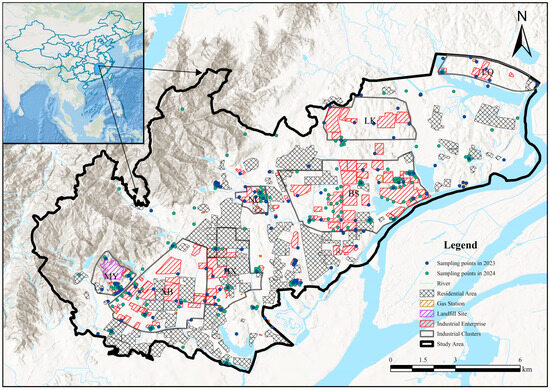
Figure 1.
Location of study area and groundwater sampling sites.
The study area exhibits a topographic gradient descending from the northwest to the southeast, with a gentle northwest–southeast inclination. Geomorphologically, it comprises three primary units: tectonically eroded hilly terrain, denudation–accumulation platform terrain and fluvial–alluvial plain terrain. Industrial clusters are predominantly distributed within the denudation–accumulation platform zone, with limited presence in the fluvial–alluvial plain areas. The study area is characterized by a predominance of sandy loam soils, with subordinate occurrences of loam and clay loam. In the study area, Quaternary and Paleogene strata exhibit extensive development, whereas Cambrian and Cretaceous formations are only sporadically exposed in localized outcrops. Groundwater is classified into three main types: pore water in loose rock formations, pore–fracture water in red beds, and fracture water in bedrock. The pore water in loose rock formations comprises alluvial deposits of the Holocene Series, Upper Pleistocene Series, and Middle Pleistocene Series, characterized by stratified sand and gravel layers. The pore–fracture water in red beds is all situated beneath the Quaternary pore aquifer. Groundwater is primarily recharged by atmospheric precipitation and exhibits a strong recharge–discharge relationship with surface water, resulting in frequent, cyclical exchange. This flow system ultimately discharges towards the east, exhibiting a distal discharge characteristic.
3. Materials and Methods
3.1. Data Sources
The water yield property and net recharge rates of aquifers were obtained from hydrogeological maps compiled by the Jiangxi Provincial Geological Bureau. The groundwater quality assessments, groundwater usage zones, groundwater table depth, aquifer thickness, soil medium, unsaturated zone medium type, and permeability coefficients were determined from field measurements. Land use types were derived from the 2020 fine classification of land cover by the Aerospace Information Research Institute, Chinese Academy of Sciences (https://www.cas.cn), and terrain slope data was sourced from NASA’s ASTER GDEM V3 global digital elevation model data (https://www.earthdata.nasa.gov). Data related to groundwater pollution loads was provided by the Nanchang Ecological and Environmental Bureau in Jiangxi Province.
In this study, a total of 339 groundwater monitoring wells were deployed, primarily monitoring unconfined aquifers. Samples were collected as follows: 138 samples between August and September 2023, 121 samples between November 2023 and January 2024, and 201 samples between April and May 2024. The sampling points in December 2023 matched those in August 2023, while the sampling points in 2024 differed from those in 2023. Before sample collection, the sampling containers were rinsed three times with well water. A portable multi-parameter water quality analyzer was used for in situ measurement of pH, with an accuracy of ±0.01 units. Total hardness was determined using the disodium EDTA titration method; total dissolved solids were measured by the gravimetric method; and sulfate and chloride were analyzed using ion chromatography. Manganese, aluminum, sodium, potassium, calcium, and magnesium were determined using inductively coupled plasma optical emission spectrometry (ICP-OES). Chemical oxygen demand was measured by the acidic potassium permanganate titration method. Ammonium nitrogen and nitrite nitrogen were analyzed using spectrophotometry, while nitrate nitrogen and fluoride were measured using ion chromatography. Bicarbonate was determined using the acid–base indicator titration method. The sampling locations are shown in Figure 1.
3.2. Analytical Methods
Groundwater in industry–city integration areas is primarily affected by industrial pollution. In this study, the groundwater risk control zones are described through three aspects: the division of key groundwater pollution prevention zones, human health risk assessment of groundwater, and groundwater pollution prediction simulations. The key groundwater pollution prevention zones are divided based on groundwater value assessment, groundwater vulnerability assessment, and groundwater pollution load assessment. The groundwater value assessment indicators include the water yield property, groundwater quality assessment, and groundwater usage zones. The groundwater vulnerability assessment includes factors such as the groundwater table depth (D), aquifer net recharge rate (R), aquifer thickness (A), soil medium (S), terrain slope (T), unsaturated zone medium type (I), permeability coefficient (C), and land use types (L). The groundwater pollution load assessment includes pollution source types, the likelihood of pollutant release, and the amount of pollutant released. The human health risk assessment of groundwater is conducted based on the USEPA human health risk assessment methodology. Groundwater pollution prediction simulations are performed on confirmed polluted sites within the study area to delineate groundwater pollution control zones. Based on the abovementioned classification process, the results from each component are overlaid to determine the first-level and secondary control zones. A flowchart of the control methods is shown in Figure 2.
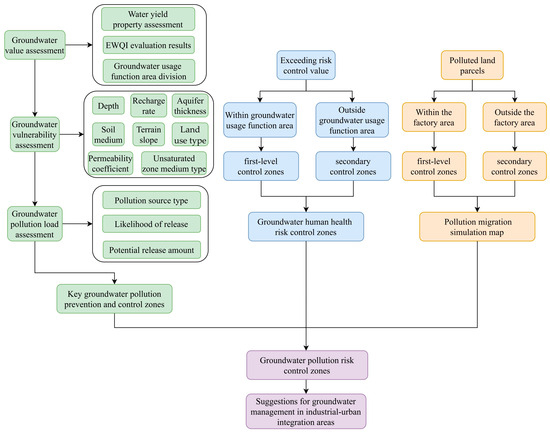
Figure 2.
Flowchart of groundwater pollution risk control zoning method.
3.2.1. Key Groundwater Pollution Prevention Zones
Groundwater Value Assessment
This study comprehensively evaluates the groundwater value in the research area by analyzing the water yield property, current groundwater quality, and groundwater usage zones. The water yield property is divided into three levels: areas with a single-well discharge greater than 1000 m3/d are classified as having strong yield properties, those with a discharge between 100 and 1000 m3/d are classified as having moderate yield properties, and those with a discharge less than 100 m3/d are classified as having weak yield properties. The study uses the Environmental Water Quality Index (EWQI) to assess the groundwater quality in the research area. The basic idea of the EWQI is to determine the weight of the evaluation indicators through entropy values, converting a large amount of water quality data into representative values that reflect the water quality status. The entropy-weight method has strong objectivity and effectively eliminates human influence in weighting calculations [2]. Areas with residential use of groundwater are classified as groundwater usage zones, while areas without residential use of groundwater are classified as non-usage zones.
Groundwater Vulnerability Assessment
The traditional method for assessing groundwater vulnerability is the DRASTIC model. However, considering that the study area is an industry–city integration zone, where land development has a negative impact on groundwater quality [42], the land use type (L) is introduced [30,43]. The DRASTIC-L model evaluation indicators include the groundwater table depth (D), aquifer net recharge rate (R), aquifer thickness (A), soil medium (S), terrain slope (T), unsaturated zone medium type (I), permeability coefficient (C), and land use type (L). The modified groundwater vulnerability index (DI) formula is as follows:
Due to the fixed values used in traditional evaluation models, this method has certain limitations for different study areas. To address this, the analytical hierarchy process (AHP) is used to replace the traditional expert scoring method for reassigning weights [9], making the results more reasonable. The groundwater vulnerability index (DI) of the DRASTIC-L model is obtained through weighted summation. The AHP method mainly involves constructing a judgment matrix, determining weights, and conducting a one-time consistency check. The importance ranking table is shown in Table 1.

Table 1.
Importance ranking table.
The final results must satisfy the consistency check, as shown in the following formula:
where CI is the consistency index that measures the deviation of the judgment matrix, λmax is the maximum eigenvalue of the matrix, n is the order of the matrix, RI is the average random consistency index, and CR is the consistency ratio. The results pass the test if CR is less than 0.1. The classification results of the DRASTIC-L model were based on the “Technical Guidelines for Defining Key Areas for Groundwater Pollution Prevention and Control (Trial)” [40] and relevant literature [44,45]. On this basis, the final classification was comprehensively determined according to the hydrogeological characteristics of the study area. The classification table is shown in Table 2.

Table 2.
Groundwater vulnerability risk assessment level classification and scoring.
Groundwater Pollution Load Assessment
The groundwater pollution load reflects the impact of human activity on groundwater. The types of pollution sources in the study area include industrial enterprises, landfills, and gas stations. This assessment evaluates the groundwater pollution load by analyzing the pollution source type (T), the likelihood of release (L), and the potential release amount (Q) of pollutants. This scoring is based on the “Technical Guidelines for Defining Key Areas for Groundwater Pollution Prevention and Control (Trial)” [40]. The pollution load for an individual pollution source is calculated as follows:
where Pi represents the pollution load risk index of source i, Ti indicates the toxicity of pollutants from source i, Li denotes the likelihood of release from source i, and Qi is the quantity of potential pollutants released.
The comprehensive pollution load assessment formula is as follows:
where PI is the comprehensive risk index of pollution sources, and Wi is the weight assigned to pollution source i. Based on hydrogeological data and field investigations, a buffer radius of 600 m was chosen for pollution sources in the study area. The groundwater pollution load assessment is determined by considering the pollutant toxicity, likelihood of release, and the quantity of potential pollutants. Regions with high pollution load (PI ≥ 60) are designated as first-level control zones, while regions with moderate pollution load (40 ≤ PI < 60) are designated as secondary control zones.
- (1)
- Pollution source types
The pollution source type represents the physicochemical properties of pollutants released from specific pollution sources. In the study area, pollution sources include industrial pollution sources, landfills, and gas stations. The scores for each type are listed in Table 3.

Table 3.
Classification and scoring of pollution source types.
- (2)
- Likelihood of pollutant release
The likelihood of pollutant release is associated with factors such as the time since the facility’s establishment and the protective measures in place. Generally, older facilities with poorer protective measures have a higher likelihood of groundwater pollution. The scoring criteria are shown in Table 4.

Table 4.
Classification and scoring of pollutant release likelihood.
- (3)
- Pollutant release quantity
The amount of pollutant released is directly proportional to the pollution area and concentration: larger areas and higher concentrations result in greater amounts of pollutants reaching groundwater. The grading and scoring for potential pollutant release quantities are shown in Table 5.

Table 5.
Classification and scoring of pollutant release quantities.
3.2.2. Human Health Risk Assessment of Groundwater
Inorganic and organic substances in groundwater can impact human health through exposure pathways such as ingestion and dermal contact [46]. This study applies the USEPA human health risk assessment method to investigate groundwater in the study area [47]. The main steps include hazard identification, exposure assessment, toxicity assessment, and risk characterization [48]. Exposure parameters specific to the study area were used in the calculations to improve accuracy. The primary exposure pathways for groundwater in the study area are ingestion and skin contact. Therefore, these two exposure pathways were selected for assessment. To ensure representativeness and comprehensively consider groundwater contamination in the area, heavy metals (Fe, Mn, Cd, Co), inorganic substances (NH4+, NO3−, As, F), and organic substances (CCl4, petroleum hydrocarbons (C10–C40)) were chosen as evaluation factors. The exposed population is divided into adults and minors.
The formulas for the route of consumption and dermal exposure are as follows [49,50,51]:
The formulas for calculating the average daily exposure (ADD) for children and adults are as follows:
Since the health effects of various substances in groundwater are cumulative [52], the total health risk is calculated as
The meanings and values of the parameters are shown in Table 6, and the intake parameters for pollutants through drinking water are listed in Table 7. The parameter selection for this project is based on the guidelines for health risk assessment of groundwater pollution [53].

Table 6.
Summary of parameters for the assessment model.

Table 7.
Drinking water pollutant intake parameters.
In this study, the acceptable non-carcinogenic hazard quotient for pollutants is set to 1, and the acceptable carcinogenic risk is set to 10−6, which facilitates the determination of risk control values for each pollutant. Groundwater health risk assessment is divided into usage and non-usage zones. In usage zones, if a groundwater indicator exceeds the groundwater risk control value and surpasses the Class III quality standard for Chinese groundwater [54], it is designated as a first-level control zone. In non-usage zones, if a groundwater indicator exceeds the risk control value and the Class IV quality standard for Chinese groundwater [54], it is designated as a secondary control zone.
3.2.3. Groundwater Pollution Prediction and Simulation
Groundwater flow in the study area is simulated using numerical modeling software, and pollution prediction simulations are conducted in areas known to be affected by contamination. Areas within the factory boundaries are designated as first-level control zones. Outside the factory boundaries, areas where pollutant concentrations are projected to exceed the Chinese groundwater Class III quality standard within the next 20 years are designated as secondary control zones.
4. Key Groundwater Pollution Prevention Zones
4.1. Groundwater Value Assessment
This study evaluates the groundwater value in the study area through a comprehensive analysis of the water yield property, groundwater quality, and groundwater use zones.
4.1.1. Water Yield Property
In the study area, regions with strong water yield properties are found only in the southeastern part, covering an area of 0.14 km2, or 0.1% of the total area. Areas with moderate water yield properties are primarily located in the western mountainous region and central areas, totaling 103.52 km2 or 64.9% of the area. Areas with low water yield properties are mainly in the southwestern part of the region, covering 55.75 km2 or 35.0%. Figure 3 covers the distribution details.
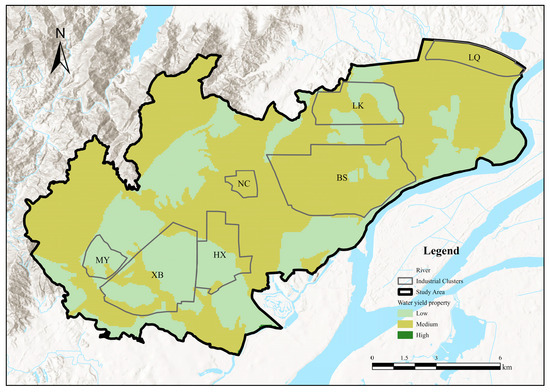
Figure 3.
Water yield property assessment map.
4.1.2. Groundwater Quality Assessment
Seventeen indicators were selected for the EWQI water quality assessment, including pH, total hardness, total dissolved solids, sulfate, chloride, manganese, aluminum, oxygen demand, ammonia nitrogen, sodium, nitrite nitrogen, nitrate nitrogen, fluoride, calcium, potassium, magnesium, and total carbonate. As the sampling locations in August and December 2023 were identical, the EWQI values for 2023 were averaged for these months.
According to the 2017 edition of the Groundwater Quality Standard [55], manganese (Mn) exhibits the highest exceedance frequency among all monitored parameters: 263 samples (57.17%) exceed the Class III groundwater standard, and 106 samples (23.04%) exceed the Class IV standard. Elevated exceedance rates are also observed for pH and NH4+-N. Specifically, 202 samples (43.91%) exceed the Class III pH standard, with 25 samples (5.43%) surpassing the Class IV standard; for NH4+-N, 113 samples (24.57%) exceed the Class III limit and 67 samples (14.57%) exceed the Class IV limit. Hydrochemically, groundwater in the study area is dominated by Ca2+ as the principal cation and HCO3− as the principal anion, yielding a prevailing HCO3–Ca facies. In discharge zones and areas subject to anthropogenic disturbance, Na+ and Cl− become the predominant ions.
Based on the EWQI results, the water quality is categorized into five classes. Among 339 samples, 79.1% had EWQI values below 100, indicating good water quality; 7.4% had values between 100 and 150, indicating moderate quality; 4.7% had values between 150 and 200, indicating poor quality; and 8.8% had values above 200, indicating very poor quality. See Figure 4 for groundwater EWQI evaluation results in the study area.
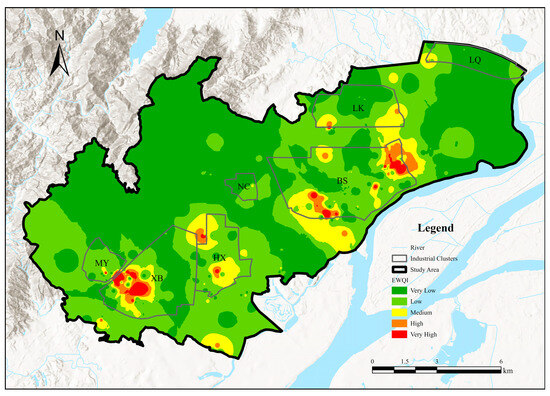
Figure 4.
EWQI evaluation results map.
4.1.3. Groundwater Use Zones
The study area has no large centralized groundwater supply sources and no extensive use of groundwater for agriculture, industry, or drinking purposes. However, field investigations revealed that some areas still have groundwater wells. These regions are designated as groundwater use zones, as shown in Figure 5.
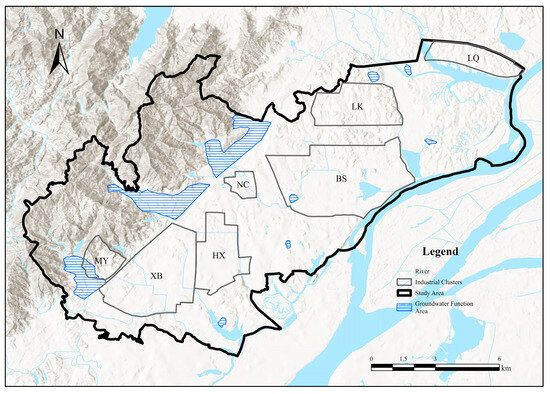
Figure 5.
Groundwater usage function area division.
4.1.4. Groundwater Function Value Evaluation Results
Based on the results of water yield property and quality assessments, a matrix is created to represent the groundwater function value, as shown in Table 8.

Table 8.
Groundwater function value matrix.
After obtaining the evaluation results, groundwater use zones are directly assigned to areas with high groundwater function values. The area of regions with high groundwater function value is 94.14 km2, accounting for 59.09%; the area with moderate groundwater function value is 11.31 km2, accounting for 7.10%; and the area with low groundwater function value is 53.87 km2, accounting for 33.81%. Figure 6 shows a detailed representation of this.
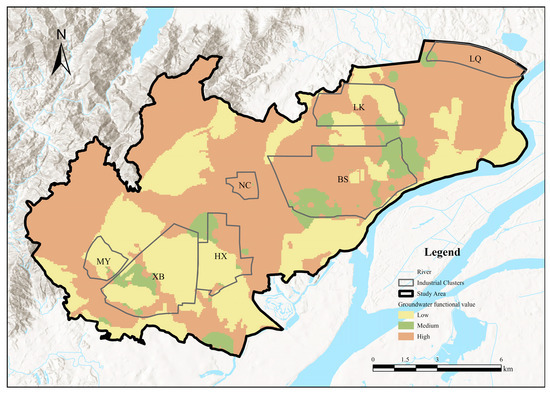
Figure 6.
Groundwater functional value zoning map.
4.2. Groundwater Vulnerability Assessment
In this study, the AHP weight range for the DRASTIC-L model is 1 to 9. Based on the judgment matrix [aij], the maximum eigenvalue λmax is calculated as 7.3287, with a CR of 0.04, which is less than 0.1, meeting the consistency requirement. The subjective weighting results are shown in Table 9, and the DRASTIC-L model formula for this study is given below. Based on the model’s classification principles, the risk assessment results for each indicator were obtained, as shown in Figure 7.

Table 9.
Pairwise judgment matrix and subjective weighting results.
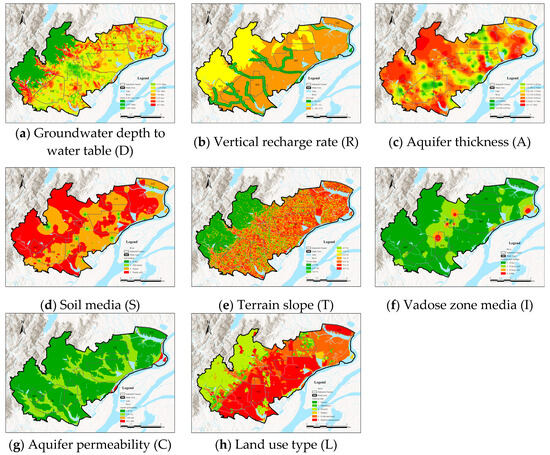
Figure 7.
Groundwater vulnerability indicator map.
This study developed a groundwater vulnerability assessment method based on the specific conditions in the study area and the characteristics of the industry–city integration zone. Using ArcGIS Pro, we conducted a layer overlay analysis by assigning relative weight values to the scoring maps for each indicator. This analysis yielded the groundwater vulnerability index for the study area, and the natural breaks classification method was then applied to divide the groundwater vulnerability into five levels: low, moderately low, moderate, moderately high, and high. A lower vulnerability index indicates that the aquifer is less susceptible to pollution, with a lower vulnerability level. Conversely, a higher index reflects greater susceptibility to pollution. The comprehensive groundwater vulnerability zoning is shown in Figure 8. The moderately high vulnerability zones are mainly concentrated in the eastern region and along riverbanks, where groundwater depths are relatively shallow and the slopes are gentle, making the groundwater more susceptible to pollution. In contrast, the moderately low vulnerability zones are primarily located in the western mountainous areas, where groundwater depths are deeper and the slopes are steeper, providing more protection from pollution.
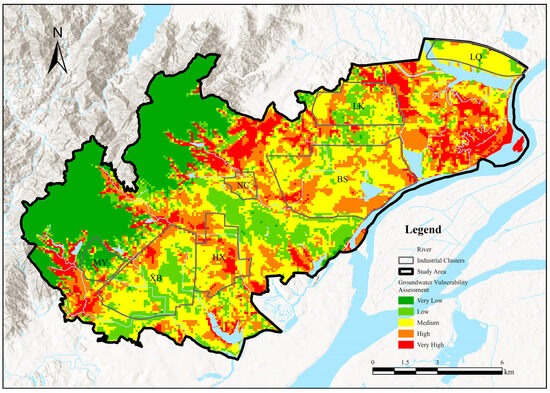
Figure 8.
Comprehensive groundwater vulnerability map.
4.3. Groundwater Pollution Load Assessment
The groundwater pollution load assessment yielded a pollution load map for the study area, categorizing regions into low, moderate, and high pollution loads. The pollution load is relatively concentrated within the industrial clusters, as shown in Figure 9. In the MY area, the presence of a municipal landfill, coupled with a contaminated site in the western section of the XB area and buffer zone effects, significantly elevates the pollution load in this region. The NC area has a long history of gear and tractor manufacturing, which presents a high pollution potential. Additionally, the BS area has a dense concentration of enterprises in heavily polluting industries such as paper manufacturing, leather, fertilizers, and hard alloy production, with many of these enterprises being large-scale, imposing a substantial pollution load on the groundwater in this area.
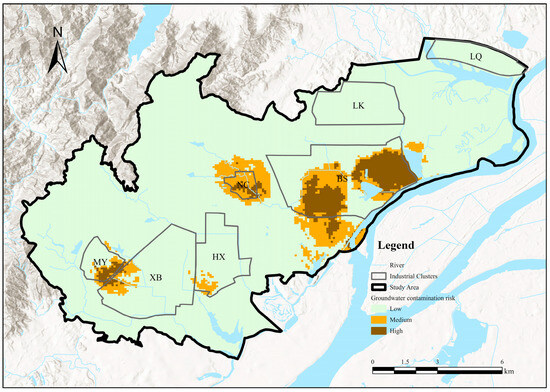
Figure 9.
Groundwater pollution load map.
4.4. Assessment Results
Based on the results of the groundwater functional value assessment, groundwater vulnerability assessment, and groundwater pollution load assessment, key zones for groundwater pollution prevention and control are delineated. Areas with both high groundwater functional value and high vulnerability are designated as key zones for groundwater pollution prevention and control. Using the groundwater pollution load map, areas with a high pollution load are designated as the first-level control zone, while areas with a moderate pollution load are designated as the secondary control zone. The total area of key zones for groundwater pollution prevention and control is 13.28 km2, accounting for 8.33% of the study area in Figure 10. The first-level control zone covers 4.44 km2 (2.78% of the study area), and the secondary control zone covers 8.84 km2 (5.55% of the study area).
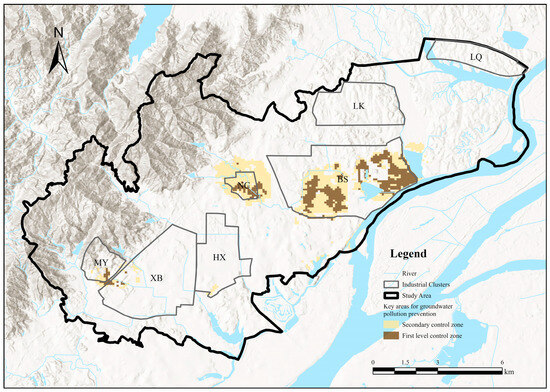
Figure 10.
Key groundwater pollution prevention and control zones map.
5. Groundwater Human Health Risk Assessment
The calculation results of the groundwater human health risk assessment are shown in Table 10. Using inverse distance weighting (IDW) interpolation, all indicators exceeding standard limits are spatially analyzed. The range of each ion exceeding the standard is shown in Figure S1–S10 of the supplementary document. In groundwater usage zones, areas exceeding risk control standards are designated as first-level control zones; in non-usage zones, areas exceeding risk control standards are designated as secondary control zones. The total area of groundwater human health risk assessment is 20.69 km2, accounting for 12.99% of the study area. The first-level control zone covers an area of 0.16 km2, accounting for 0.10% of the total area, while the secondary control zone covers 20.53 km2, or 12.89%, of the total area. The risk control scope is shown in Figure 11. Groundwater health risk control zones are widely distributed across the study area, primarily due to the impact of industrial activities on groundwater pollution and the naturally high background value of manganese in the study area [56].

Table 10.
Statistical results of groundwater human health risk assessment calculations.
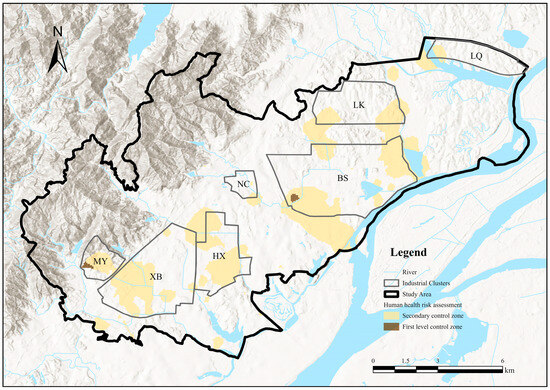
Figure 11.
Groundwater human health risk control zones map.
6. Groundwater Pollution Prediction and Simulation
The groundwater levels and shallow groundwater quality in the study area are significantly impacted by human activity [57,58]. The primary groundwater type is HCO3−-Ca2+ [56], and the region exhibits high background concentrations of manganese and iron [59], with groundwater in certain areas already being affected by industrial activities. By analyzing the groundwater pollution prevention priority zones and human health risk assessment, the groundwater areas within the study area that require particular attention were identified. However, previous research has focused solely on the current state of a region and lacks future pollution predictions. Therefore, this study introduces groundwater pollution prediction simulations to assess the potential future impacts of current pollution levels.
6.1. Model Development
A groundwater model was constructed for the study area using MODFLOW. Given that the western mountainous area has few residents and industries, it was excluded from the simulation area. The aquifer in the study area consists mainly of porous and fractured water and is simplified as a unified aquifer system. The eastern boundary is defined by rivers with constant head boundaries, while the western boundary, set along the foothills, is defined by a constant flow boundary. The northern and southern boundaries align with administrative borders and are represented by general head boundaries. Considering the presence of numerous rivers and lakes within the simulated range, the area is represented using both general head and constant head boundaries. A steady-state groundwater flow simulation was obtained through condition simplification, showing the overall groundwater flow from the western mountains toward the eastern rivers. The simulated area in this study covers 139.32 km2. Based on the extent and shape of the simulation area, the model domain was divided into 152 rows and 194 columns, yielding a total of 29,488 grid cells with a horizontal resolution of 100 × 100 m. Among them, there are 13,932 active cells. According to the geological and geomorphological conditions, as well as hydrogeological characteristics, the permeability coefficient of the phreatic aquifer system was divided into several zones, with the horizontal permeability coefficient ranging from 0.3 to 150 m/d. Rainfall recharge coefficient zones were determined through model fitting and lithological classification of the study area, with recharge intensity varying from 0.0001 m/d to 0.0015 m/d, and the evaporation limit depth was set to 4 m. There are numerous rivers and lakes within the study area, and the interaction between surface water and groundwater is significant. To simulate this interaction, five rivers and five lakes were incorporated into the model. Rivers were defined as general head boundaries, while lakes were set as constant head boundaries. The specific parameter selection of the model and the fitting verification of the groundwater level can be found in Section 2 groundwater pollution prediction and simulation of the supplementary document. The groundwater flow simulation map is presented in Figure 12.
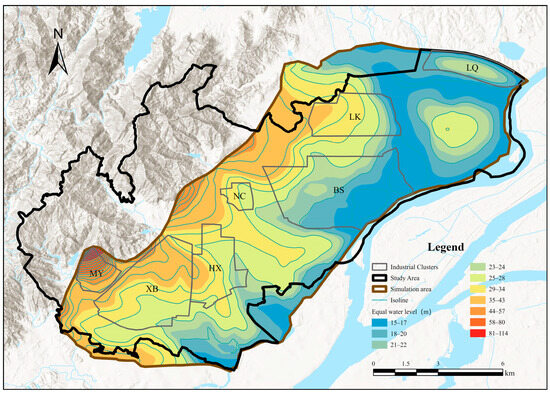
Figure 12.
Groundwater flow simulation map.
6.2. Evaluation Results
For this simulation, seven contaminated sites identified in prior investigations were selected. The groundwater simulation timeframe was determined based on the site’s 20-year industrial operation history, serving as the scientific basis for defining the predictive period [60]. The MT3DMS module was used to simulate contaminant migration over 7300 days. Contaminated sites within plant boundaries were designated as first-level control zones, while areas where contaminants migrated beyond plant boundaries were designated as secondary control zones. The total area of groundwater pollution prediction and simulation is 1.85 km2, accounting for 1.16% of the study area. The first-level control zone covers an area of 1.24 km2, accounting for 0.78% of the total area, while the secondary control zone covers 0.61 km2, or 0.38%, of the total area. The simulation of overall contaminant migration is shown in Figure 13.
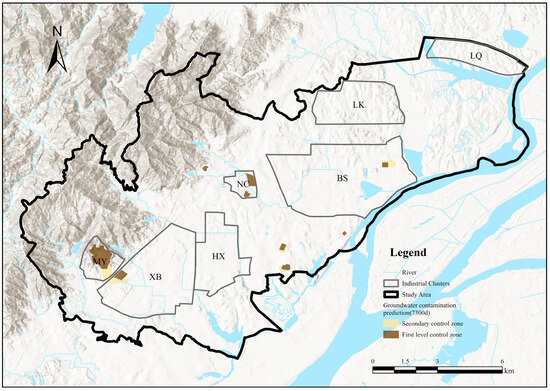
Figure 13.
Pollution migration simulation map (7300 days).
7. Groundwater Pollution Risk Control Zone Assessment Results
Groundwater pollution risk control zones were identified by overlaying the results from groundwater pollution prevention priority zone identification, human health risk assessment, and pollution prediction simulations. The first-level control zone was defined by overlaying and taking the highest value from each zone’s first-level control areas, and the secondary control zone was similarly defined based on the first-level control zones. The total area of groundwater pollution risk control zones is 30.37 km2, accounting for 19.06% of the study area. The first-level control zone covers 5.38 km2 (3.38% of the total area), while the secondary control zone covers 24.99 km2 (15.68% of the total area). The first-level control zone is primarily within the industrial clusters, while the secondary control zone is broadly distributed throughout the area, as shown in Figure 14.
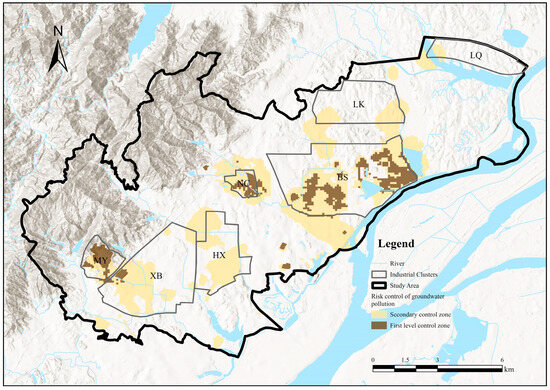
Figure 14.
Groundwater pollution risk control zones map.
Compared with the groundwater pollution prevention priority zoning method [40], the risk control strategy that incorporates groundwater pollution risk prediction simulation delineated a broader control area. Specifically, the first-level control zone increased by 0.94 km2, and the second-level control zone expanded by 16.15 km2. In some groundwater pollution risk areas, the traditional method failed to identify certain zones, whereas the approach adopted in this study successfully supplemented those omitted areas, effectively reflecting the current status of groundwater pollution and accounting for potential future pollution scenarios. The groundwater pollution risk control zones defined in this study are more suitable for application in industry–city integration areas, with a wider coverage and greater scientific rationale, thereby enhancing the capacity of environmental authorities to effectively manage and protect groundwater resources.
8. Conclusions and Recommendations
- (1)
- Through groundwater pollution risk control, it is found that the first-level control zone in the study area covers 5.38 km2, accounting for 3.37% of the total area, while the secondary control zone covers 24.99 km2, or 15.68%, of the total area. The combined control zone area totals 30.37 km2, comprising 19.06% of the study area. The first-level control zone is mainly concentrated in industrial clusters, with the secondary control zone distributed broadly across the region.
- (2)
- In comparison to traditional methods for defining groundwater pollution prevention priority areas, the groundwater pollution risk control strategy identifies more extensive control zones. The first-level control zone area increased by 0.94 km2, and the secondary control zone area expanded by 16.15 km2. This method provides more suitable outcomes for industry–city integration zones, enabling environmental management agencies to more effectively monitor and protect groundwater environments.
- (3)
- For active enterprises within the first-level control zones, it is recommended to conduct quarterly groundwater environmental monitoring and perform soil and groundwater pollution risk investigations. For inactive enterprises, risk-based control measures should be implemented, and effective measures should be promptly taken to prevent pollution spread in already contaminated sites.
- (4)
- The secondary control zones should strengthen regional environmental monitoring and risk investigations. It is recommended that areas with potential human health impacts conduct environmental monitoring twice annually, based on the region’s monitoring network, to track pollution trends. Additionally, since some wells remain in certain control areas, residents should be guided by the government to seal groundwater wells, with unauthorized groundwater extraction being strictly prohibited.
Supplementary Materials
The following supporting information can be downloaded at https://www.mdpi.com/article/10.3390/w17152249/s1. Figures S1–S10 show the range of exceedance (including Fe, Mn, Cd, Co, NH4+-N, As, NO3−-N, F, CCl4, petroleum hydrocarbons (C10–C40). Figure S11 Simulation boundary setup. Figure S12 Three-Dimensional grid layout. Figure S13 Hydraulic conductivity zoning map. Figure S14 Rainfall infiltration coefficient zoning map. Figure S15 Surface water representation map. Figure S16 Comparison of observed and simulated groundwater levels.
Author Contributions
Conceptualization, X.Q., G.W. and Z.Z.; Methodology, Z.S.; Investigation, L.Z. and Z.Z.; Resources, L.Z.; Writing—original draft, X.Q. and T.C.; Writing—review & editing, X.Q., T.C. and Z.Z.; Visualization, Z.S.; Supervision, N.S.; Project administration, N.S. and Z.D.; Funding acquisition, N.S. and Z.D. All authors have read and agreed to the published version of the manuscript.
Funding
This research received no external funding.
Data Availability Statement
All processed data generated or used during the study appear in the submitted article. Raw data will be provided upon reasonable request from the corresponding author.
Conflicts of Interest
The authors declare no conflicts of interest.
References
- Wang, Y.; Yuan, S.; Shi, J.; Ma, T.; Xie, X.; Deng, Y.; Du, Y.; Gan, Y.; Guo, Z.; Dong, Y.; et al. Groundwater Quality and Health: Making the Invisible Visible. Environ. Sci. Technol. 2023, 57, 5125–5136. [Google Scholar] [CrossRef] [PubMed]
- Zhang, Z.; Wang, H.; Shi, Z.; Sun, N. Temporal and Spatial Evolution of Groundwater Natural Background Levels in a Rapid Urbanization Area, Northeast of Beijing, China. Expo Health 2024, 16, 341–355. [Google Scholar] [CrossRef]
- Cao, H.; Xie, X.; Shi, J.; Jiang, G.; Wang, Y. Siamese Network-Based Transfer Learning Model to Predict Geogenic Contaminated Groundwaters. Environ. Sci. Technol. 2022, 56, 11071–11079. [Google Scholar] [CrossRef] [PubMed]
- Haggerty, R.; Sun, J.; Yu, H.; Li, Y. Application of Machine Learning in Groundwater Quality Modeling—A Comprehensive Review. Water Res. 2023, 233, 119745. [Google Scholar] [CrossRef]
- Shi, H.; Zeng, M.; Peng, H.; Huang, C.; Sun, H.; Hou, Q.; Pi, P. Health Risk Assessment of Heavy Metals in Groundwater of Hainan Island Using the Monte Carlo Simulation Coupled with the APCS/MLR Model. Int. J. Environ. Res. Public Health 2022, 19, 7827. [Google Scholar] [CrossRef]
- Shrestha, S.; Semkuyu, D.J.; Pandey, V.P. Assessment of Groundwater Vulnerability and Risk to Pollution in Kathmandu Valley, Nepal. Sci. Total Environ. 2016, 556, 23–35. [Google Scholar] [CrossRef]
- Xiang, Z.; Wu, S.; Zhu, L.; Yang, K.; Lin, D. Pollution Characteristics and Source Apportionment of Heavy Metal(Loid)s in Soil and Groundwater of a Retired Industrial Park. J. Environ. Sci. 2024, 143, 23–34. [Google Scholar] [CrossRef]
- Bera, A.; Mukhopadhyay, B.P.; Das, S. Groundwater Vulnerability and Contamination Risk Mapping of Semi-Arid Totko River Basin, India Using GIS-Based DRASTIC Model and AHP Techniques. Chemosphere 2022, 307, 135831. [Google Scholar] [CrossRef]
- Ozegin, K.O.; Ilugbo, S.O.; Adebo, B. Spatial Evaluation of Groundwater Vulnerability Using the DRASTIC-L Model with the Analytic Hierarchy Process (AHP) and GIS Approaches in Edo State, Nigeria. Phys. Chem. Earth 2024, 134, 103562. [Google Scholar] [CrossRef]
- Babiker, I.S.; Mohamed, M.a.A.; Hiyama, T.; Kato, K. A GIS-Based DRASTIC Model for Assessing Aquifer Vulnerability in Kakamigahara Heights, Gifu Prefecture, Central Japan. Sci. Total Environ. 2005, 345, 127–140. [Google Scholar] [CrossRef]
- Vias, J.M.; Andreo, B.; Perles, M.J.; Carrasco, F.; Vadillo, I.; Jimenez, P. Proposed Method for Groundwater Vulnerability Mapping in Carbonate (Karstic) Aquifers: The COP Method. Hydrogeol. J. 2006, 14, 912–925. [Google Scholar] [CrossRef]
- Rahman, A. A GIS Based DRASTIC Model for Assessing Groundwater Vulnerability in Shallow Aquifer in Aligarh, India. Appl. Geogr. 2008, 28, 32–53. [Google Scholar] [CrossRef]
- Huan, H.; Wang, J.; Teng, Y. Assessment and Validation of Groundwater Vulnerability to Nitrate Based on a Modified DRASTIC Model: A Case Study in Jilin City of Northeast China. Sci. Total Environ. 2012, 440, 14–23. [Google Scholar] [CrossRef] [PubMed]
- Sajedi-Hosseini, F.; Malekian, A.; Choubin, B.; Rahmati, O.; Cipullo, S.; Coulon, F.; Pradhan, B. A Novel Machine Learning-Based Approach for the Risk Assessment of Nitrate Groundwater Contamination. Sci. Total Environ. 2018, 644, 954–962. [Google Scholar] [CrossRef]
- El Osta, M.; Hussein, H.; Tomas, K. Numerical Simulation of Groundwater Flow and Vulnerability in Wadi El-Natrun Depression and Vicinities, West Nile Delta, Egypt. J. Geol. Soc. India 2018, 92, 235–247. [Google Scholar] [CrossRef]
- Barbulescu, A. Assessing Groundwater Vulnerability: DRASTIC and DRASTIC-Like Methods: A Review. Water 2020, 12, 1356. [Google Scholar] [CrossRef]
- Goyal, D.; Haritash, A.K.; Singh, S.K. A Comprehensive Review of Groundwater Vulnerability Assessment Using Index-Based, Modelling, and Coupling Methods. J. Environ. Manag. 2021, 296, 113161. [Google Scholar] [CrossRef]
- Wang, J.; He, J.; Chen, H. Assessment of Groundwater Contamination Risk Using Hazard Quantification, a Modified DRASTIC Model and Groundwater Value, Beijing Plain, China. Sci. Total Environ. 2012, 432, 216–226. [Google Scholar] [CrossRef] [PubMed]
- Aller, L.; Bennett, T.; Lehr, J.; Petty, R.; Hackett, G. DRASTIC: Standardized System for Evaluating Groundwater Pollution Potencial Using Hydrogeologic Settings. J. Geol. Soc. India 1987, 29, 23–37. [Google Scholar] [CrossRef]
- Taghavi, N.; Niven, R.K.; Paull, D.J.; Kramer, M. Groundwater Vulnerability Assessment: A Review Including New Statistical and Hybrid Methods. Sci. Total Environ. 2022, 822, 153486. [Google Scholar] [CrossRef]
- Yu, H.; Wu, Q.; Zeng, Y.; Zheng, L.; Xu, L.; Liu, S.; Wang, D. Integrated Variable Weight Model and Improved DRASTIC Model for Groundwater Vulnerability Assessment in a Shallow Porous Aquifer. J. Hydrol. 2022, 608, 127538. [Google Scholar] [CrossRef]
- Thirumalaivasan, D.; Karmegam, M.; Venugopal, K. AHP-DRASTIC: Software for Specific Aquifer Vulnerability Assessment Using DRASTIC Model and GIS. Environ. Modell. Softw. 2003, 18, 645–656. [Google Scholar] [CrossRef]
- Sener, E.; Davraz, A. Assessment of Groundwater Vulnerability Based on a Modified DRASTIC Model, GIS and an Analytic Hierarchy Process (AHP) Method: The Case of Egirdir Lake Basin (Isparta, Turkey). Hydrogeol. J. 2013, 21, 701–714. [Google Scholar] [CrossRef]
- Bera, A.; Mukhopadhyay, B.P.; Chowdhury, P.; Ghosh, A.; Biswas, S. Groundwater Vulnerability Assessment Using GIS-Based DRASTIC Model in Nangasai River Basin, India with Special Emphasis on Agricultural Contamination. Ecotox. Environ. Saf. 2021, 214, 112085. [Google Scholar] [CrossRef] [PubMed]
- Anane, M.; Abidi, B.; Lachaal, F.; Limam, A.; Jellali, S. GIS-Based DRASTIC, Pesticide DRASTIC and the Susceptibility Index (SI): Comparative Study for Evaluation of Pollution Potential in the Nabeul-Hammamet Shallow Aquifer, Tunisia. Hydrogeol. J. 2013, 21, 715–731. [Google Scholar] [CrossRef]
- Allafta, H.; Opp, C.; Patra, S. Identification of Groundwater Potential Zones Using Remote Sensing and GIS Techniques: A Case Study of the Shatt Al-Arab Basin. Remote Sens. 2021, 13, 112. [Google Scholar] [CrossRef]
- Torkashvand, M.; Neshat, A.; Javadi, S.; Pradhan, B. New Hybrid Evolutionary Algorithm for Optimizing Index-Based Groundwater Vulnerability Assessment Method. J. Hydrol. 2021, 598, 126446. [Google Scholar] [CrossRef]
- Alizadeh, M.R.; Adamowski, J.; Inam, A. Integrated Assessment of Localized SSP-RCP Narratives for Climate Change Adaptation in Coupled Human-Water Systems. Sci. Total Environ. 2022, 823, 153660. [Google Scholar] [CrossRef]
- Sivakumar, V.; Kumar, M.C.S.; Natarajan, L.; Roy, P.D.; Chokkalingam, L. Vulnerability Assessment of Groundwater in Industrialized Tiruppur Area of South India Using GIS-Based DRASTIC Model. J. Geol. Soc. India 2022, 98, 696–702. [Google Scholar] [CrossRef]
- Zhang, Q.; Li, P.; Lyu, Q.; Ren, X.; He, S. Groundwater Contamination Risk Assessment Using a Modified DRATICL Model and Pollution Loading: A Case Study in the Guanzhong Basin of China. Chemosphere 2022, 291, 132695. [Google Scholar] [CrossRef]
- Zhao, X.; Wang, D.; Xu, H.; Ding, Z.; Shi, Y.; Lu, Z.; Cheng, Z. Groundwater Pollution Risk Assessment Based on Groundwater Vulnerability and Pollution Load on an Isolated Island. Chemosphere 2022, 289, 133134. [Google Scholar] [CrossRef] [PubMed]
- Kumar, S.; Rahman, M.A.; Islam, M.R.; Abul Hashem, M.; Rahman, M.M. Lead and Other Elements-Based Pollution in Soil, Crops and Water near a Lead-Acid Battery Recycling Factory in Bangladesh. Chemosphere 2022, 290, 133288. [Google Scholar] [CrossRef]
- Ullah, Z.; Rashid, A.; Ghani, J.; Nawab, J.; Zeng, X.-C.; Shah, M.; Alrefaei, A.F.; Kamel, M.; Aleya, L.; Abdel-Daim, M.M.; et al. Groundwater Contamination through Potentially Harmful Metals and Its Implications in Groundwater Management. Front. Environ. Sci. 2022, 10, 1021596. [Google Scholar] [CrossRef]
- Wan, Y.; Chen, X.; Liu, Q.; Hu, H.; Wu, C.; Xue, Q. Informal Landfill Contributes to the Pollution of Microplastics in the Surrounding Environment. Environ. Pollut. 2022, 293, 118586. [Google Scholar] [CrossRef] [PubMed]
- Xu, H.; Yang, X.; Wang, D.; Hu, Y.; Cheng, Z.; Shi, Y.; Zheng, P.; Shi, L. Multivariate and Spatio-Temporal Groundwater Pollution Risk Assessment: A New Long-Time Serial Groundwater Environmental Impact Assessment System. Environ. Pollut. 2023, 317, 120621. [Google Scholar] [CrossRef] [PubMed]
- Guo, Y.; Li, P.; He, X.; Wang, L. Groundwater Quality in and Around a Landfill in Northwest China: Characteristic Pollutant Identification, Health Risk Assessment, and Controlling Factor Analysis. Expo. Health 2022, 14, 885–901. [Google Scholar] [CrossRef]
- Sundar, M.L.; Ragunath, S.; Hemalatha, J.; Vivek, S.; Mohanraj, M.; Sampathkumar, V.; Ansari, A.M.S.; Parthiban, V.; Manoj, S. Simulation of Ground Water Quality for Noyyal River Basin of Coimbatore City, Tamilnadu Using MODFLOW. Chemosphere 2022, 306, 135649. [Google Scholar] [CrossRef]
- Ministry of Ecology and Environment. Guidelines for the Division of Groundwater Pollution Prevention and Control Zones (Trial); Ministry of Ecology and Environment: Beijing, China, 2014.
- Ministry of Ecology and Environment. Guidelines for Zoning of Groundwater Pollution Prevention and Control Zones; Ministry of Ecology and Environment: Beijing, China, 2019.
- Ministry of Ecology and Environment. Technical Guidelines for Defining Key Areas for Groundwater Pollution Prevention and Control (Trial); Ministry of Ecology and Environment: Beijing, China, 2023.
- Holding, S.; Allen, D.M.; Foster, S.; Hsieh, A.; Larocque, I.; Klassen, J.; Van Pelt, S.C. Groundwater Vulnerability on Small Islands. Nat. Clim. Chang. 2016, 6, 1100–1103. [Google Scholar] [CrossRef]
- He, S.; Li, P.; Wu, J.; Elumalai, V.; Adimalla, N. Groundwater Quality under Land Use/Land Cover Changes: A Temporal Study from 2005 to 2015 in Xi’an, Northwest China. Hum. Ecol. Risk Assess. Int. J. 2020, 26, 2771–2797. [Google Scholar] [CrossRef]
- Kazakis, N.; Voudouris, K.S. Groundwater Vulnerability and Pollution Risk Assessment of Porous Aquifers to Nitrate: Modifying the DRASTIC Method Using Quantitative Parameters. J. Hydrol. 2015, 525, 13–25. [Google Scholar] [CrossRef]
- Xiong, Y.; Liu, J.; Yuan, W.; Liu, W.; Ma, S.; Wang, Z.; Li, T.; Wang, Y.; Wu, J. Groundwater Contamination Risk Assessment Based on Groundwater Vulnerability and Pollution Loading: A Case Study of Typical Karst Areas in China. Sustainability 2022, 14, 9898. [Google Scholar] [CrossRef]
- Hou, Y.; Dou, X.; Bao, S.; Gao, H.; Yang, Y.; Wen, Y.; Wang, M. Assessment of groundwater contamination risk based on improved DRASTIC model. Acta Sci. Circumstantiae 2024, 44, 227–236. [Google Scholar] [CrossRef]
- Siddiqua, A.; Hahladakis, J.N.; Al-Attiya, W.A.K.A. An Overview of the Environmental Pollution and Health Effects Associated with Waste Landfilling and Open Dumping. Environ. Sci. Pollut. Res. 2022, 29, 58514–58536. [Google Scholar] [CrossRef] [PubMed]
- Wang, Y.; Liu, J.; Yu, X.; Yan, Y.; Chen, Q.; Chen, S. Evaluation of Groundwater Quality and Health Risk Assessment in Southeastern Tibet, China. Environ. Earth Sci. 2023, 82, 455. [Google Scholar] [CrossRef]
- Wang, Y.; Li, P. Appraisal of Shallow Groundwater Quality with Human Health Risk Assessment in Different Seasons in Rural Areas of the Guanzhong Plain (China). Environ. Res. 2022, 207, 112210. [Google Scholar] [CrossRef]
- US EPA. Risk Assessment Guidance for Superfund Volume: Human Health Evaluation Manual. Supplemental Guidance: “Standard Default Exposure Factors” Final Interim Report (Directive); US EPA: Washington, DC, USA, 1991.
- US EPA. Guidance for Exposure Assessment; US EPA: Washington, DC, USA, 1992.
- Liu, H.; Xie, H.; Lin, Y.; Xin, B.; Yang, G.; Li, J.; Zhou, S. Source Analysis and Health Risk Assessment of Metal Elements in Karst Groundwater of Qingjiang River Basin. Environ. Sci. Technol. 2024, 47, 138–148. [Google Scholar] [CrossRef]
- Xiao, Y.; Hao, Q.; Zhang, Y.; Zhu, Y.; Yin, S.; Qin, L.; Li, X. Investigating Sources, Driving Forces and Potential Health Risks of Nitrate and Fluoride in Groundwater of a Typical Alluvial Fan Plain. Sci. Total Environ. 2022, 802, 149909. [Google Scholar] [CrossRef]
- Ministry of Ecology and Environment. Guidelines for Health Risk Assessment of Groundwater Pollution; Ministry of Ecology and Environment: Beijing, China, 2019.
- GB/T 14848–2017; Bureau of Quality and Technical Supervision of China Standard of Groundwater Quality. China Standard Press: Beijing, China, 2017.
- GB/T 14848-2017; General Administration of Quality Supervision, Inspection and Quarantine of China. Standardization Administration of China Groundwater Quality Standards. Standards Press of China: Beijing, China, 2017.
- Ma, Q.; Ge, W.; Tian, F. Geochemical Characteristics and Controlling Factors of Chemical Composition of Groundwater in a Part of the Nanchang Section of Ganfu Plain. Sustainability 2022, 14, 7976. [Google Scholar] [CrossRef]
- Ma, Q.; Jia, J.; Tian, F.; Chen, C. Groundwater Vulnerability Assessment Using Gis Based Modified Drastic Model in Nanchang City, China. Fresenius Environ. Bull. 2021, 30, 997–1009. [Google Scholar]
- He, J.; Mao, H.; Xue, Y.; Liao, F.; Gao, B.; Rao, Z.; Yang, Y.; Liu, Y.; Wang, G. Variability in Spatiotemporal Groundwater Nitrate Concentrations in the Northeast Ganfu Plain. Earth Sci. Front. 2024, 31, 360–370. [Google Scholar] [CrossRef]
- Chu, X.; Ma, Z.; Wu, D.; Wang, H.; He, J.; Chen, T.; Zheng, Z.; Li, H.; Wei, P. High Fe and Mn Groundwater in the Nanchang, Poyang Lake Basin of China: Hydrochemical Characteristics and Genesis Mechanisms. Environ. Monit. Assess. 2023, 195, 124. [Google Scholar] [CrossRef] [PubMed]
- Ministry of Ecology and Environment. Technical Guidelines for Environmental Impact Assessment-Groundwater Environment; Ministry of Ecology and Environment: Beijing, China, 2016.
Disclaimer/Publisher’s Note: The statements, opinions and data contained in all publications are solely those of the individual author(s) and contributor(s) and not of MDPI and/or the editor(s). MDPI and/or the editor(s) disclaim responsibility for any injury to people or property resulting from any ideas, methods, instructions or products referred to in the content. |
© 2025 by the authors. Licensee MDPI, Basel, Switzerland. This article is an open access article distributed under the terms and conditions of the Creative Commons Attribution (CC BY) license (https://creativecommons.org/licenses/by/4.0/).